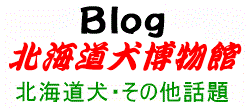for-information-eng
Welcome to the Hokkaido-Inu Museum !
A part of the article of this page was contributed to Hokkaido_(dog) in Wikipedia by us.


Let's call the Hokkaido-Inu the Ainu Dog !
INFORMATION
(Hokkaido-Inu)
|
|
|
|
Welcome to the Hokkaido-Inu Museum !
A part of the article of this page was contributed to Hokkaido_(dog) in Wikipedia by us.


Let's call the Hokkaido-Inu the Ainu Dog !
INFORMATION
(Hokkaido-Inu)
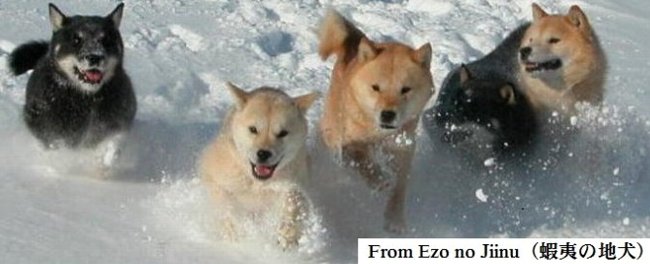 |
||
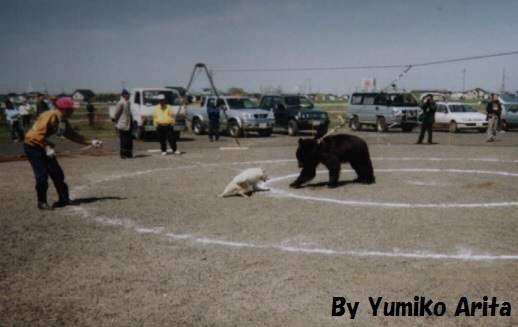 |
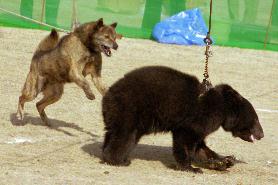 |
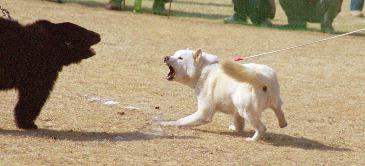 |
|
Japanese scientist Keiichi Omoto researched by molecular
biological technique about the origin of Japanese people. On the other hand, Yuichi Tanabe investigated the strains of the native Japanese dog breeds by the same technique. Using blood, DNA was extracted and genetic distance for mitochondrial DNA was estimated between these dog breeds. The part of the following information is written to make good use of their researchs. |
| NATIVE JAPANESE BREEDS By the way, the Shiba is classified into three types, the Sanin-Shiba, the Shinsyu-Shiba and the Mino-Shiba. As a matter of fact, it is the Shinsyu-Shiba that we usually call the Shiba. The gene combinations of the Shinsyu-Shiba differs from the Sanin-Shiba or the Mino-Shiba. Originally both the Akita-Inu and the Tosa-Inu were native Japanese dogs, but they were mixed with the Western breeds. Strictly speaking, they are not pure-blooded Japanese dogs (especially the Tosa). Among the Japanese people, the Akita, the Kai, the Kisyu, the Shiba and the Tosa are well-known, but many people don't know the Hokkaido, the Ryukyu and the Shikoku. Also the Japanese Chin, the Japanese Spitz and the Japanese Terrier are overseas dogs. They are not really native Japanese dogs. Because of the great confusion during the 2nd World War, the number of the Japanese breeds decreased sharply. But the breeds have been more protected than ever by the efforts of the dog fanciers and the preservation societies after the War. 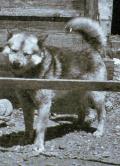 The
Hokkaido-Inu in the 1950s The
Hokkaido-Inu in the 1950sIn the 1930s, the Akita, the Hokkaido, the Kai, the Kisyu, the Shiba, and the Shikoku were designated as "a rare species protected by law." The Ryukyu was protected in 1995. |
| NAMES The Hokkaido-Inu had been called the Ainu-Ken (Ainu Dog). In 1869 T. Blakiston (from Britain) named the dog the Ainu Dog. The Japanese people know him well, because in 1880 he proposed the Blakiston's Line that the Hokkaido Island's species differ from the Honsyu Island's ones through the study of birds distribution. In 1937, the Ainu dog was designated in Japan as "a rare species protected by law" and it was decided that the official name of the breed would be Hokkaido-Inu. However, the dogs are almost always called Hokkaido-Ken among the Japanese people. In the Japanese language, both "Inu" and "Ken" mean dog, but "Ken" is usually used with a noun such as the local name (for example, Hokkaido-Ken, Kai-Ken, and Shikoku-Ken). In fact, the use of “Inu” with a noun is generally considered incorrect. Thus, while the formal name in Japan is Hokkaido-Inu, the expression Hokkaido-Ken is more generally used in the spoken language. |
HISTORY
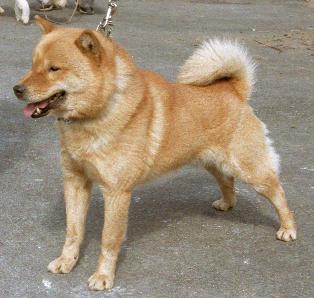 The Hokkaido-Inu is one of the native Japanese dog breeds. It also has been known as "the Ainu-Ken (Ainu Dog)." Because the Ainu people (the indigenous people of Hokkaido) bred the dog to use for hunting bears and deer. The strength and physique of this breed enables the dog to withstand severe cold, heavy snowfalls, dense forests, and the rugged terrain in Hokkaido. The history of the dog is very closely tied with the history of the Ainu people. This ancient Ainu people first settled in the whole of Japan with their dogs. They are the indigenious people of Japan. According to some hypothesis, they are the descendants of Southern Mongoloid migrants who entered the Japanese Islands several tens of thousands of years ago, before the Jomon Period (8000 BC to 300 BC). However, in the Yayoi Period (300 BC to 250 AD) and Tumulus Period, Northern Mongoloid migrants entered the Honsyu Island with their dogs and so the original Ainu people were mixed with them and also the dogs. By the way, because they were so far away, the old ones who lived in the Okinawa Islands, the Tohoku district and the Hokkaido Island were not mixed and also their dogs. Through research on the minute variations in skull structure, there is a hypothesis that the Okinawa people are related to the Honsyu people, but not the Ainu people.  Distribution map of Ainu people in the recent times (From the Ainu Museum)
Thus the Hokkaido-Inu came into
existence in Hokkaido -- also the Ryukyu-Inu did so in
Okinawa. Both the Hokkaido and the Ryukyu probably were
southern dogs originally.
As the dogs mixed, the Kai-Inu, the Kisyu-Inu, the Shiba-Inu and the Shikoku-Inu were bred in the other islands of Honsyu, Kyusyu, and Shikoku. 
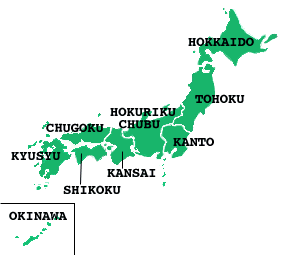 |
| AINU PEOPLE The Ainu people's history has been an unhappy and sad one; however, they have had a noble heart and an unique culture without having a written language for themselves. The pure Ainu Culture continued from about 1400 to the early 1700s. "Ainu" means "human." They had "kamuy" (gods) and performed various ceremonies for the gods. These gods include ; diverse gods, such as fire, water, wind, thunder, bears, foxes, aconite, mushroom, boats, pots, houses, mountains, and lakes. In the mid-1400s, the Japanese people extended their influence over southern Hokkaido. Later, they came to further oppress the Ainu people. To resist the oppression and exploitation by the Japanese people, the Ainu people waged some battles, but they fell completely under the control of the Japanese people. Since the late 1800s, the Ainu people were forced to obey Japanese daily customs. In 1899, the Hokkaido Aborigine Protection Act was passed. However, the act designated the Ainu people as "former aborigines" and clarified the distinction between the Japanese people and the Ainu people. In 1961, the Hokkaido Utari Association (the Ainu Association of Hokkaido) was established. "Utari" means "fellow countryman." The association has actively tackled the various problems regarding the Ainu people. Soon the association demanded that the Japanese Government should enact the New Ainu Law, and finally the law was enacted in 1997. It is a significant law for the Ainu people, because it widely accepts the Ainu people as an ethnic minority. As they had been mixed with the Japanese people, now there are so few pure-blooded Ainu people and they usually live as a Japanese person. Don't be under an illusion that an Ainu person who is wearing Ainu folk costumes is going to be with an Ainu dog (Hokkaido dog). There is no school for the children of the Ainu people. These days, under the people who have a connection to the Ainu people, various activities are being vigorously promoted to preserve and maintain the Ainu Culture, such as the Ainu language, the traditional dancing, and the various ceremonies. |
CHARACTERISTIC

The dog appears simple, wild, and
powerful as is its nature.
They are a very well-behaved breed.It is impulsive and fast and has a light gait. The stop (a long, narrow hollow in the middle of forehead) is shallow but defined, therefore the dog has a gentle look. The dog howls like a wolf when he is happy to see his owner. He can't become a police dog, because he is so independent. You shouldn't let the dog loose out of doors, because he don't come back at hand. He sometimes ignores "come" if he has more important things to do. Even if you send your Ainu adult dog to training school, the dog would return home without becoming good like the other native Japanese breeds. And he bites a trainer. It usually obeys the owner with gentle responsiveness and likes a lot of affection, however, it is very brave and shows manly features. It is fearless and a determined hunter and has been known to attack a 650 pound brown bear. |
Most of the dogs have spots of black on a tongue.
 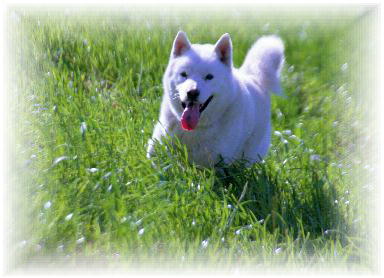 It is desirable that a completely white dog has its nose
leather black not
beige.
It is desirable that a completely white dog has its nose
leather black not
beige. |
| Some dogs may bite humans or other animals. Some veterinarians are afraid of the dogs. But now we have lots of dogs that do not bite. |
|
FAULTS
If your dog has the following faults, he would get many points off in competition. (1) He doesn't have a good bite (occlusion). (2) He doesn't have any teeth to come through. (3) In the case of a white dog, all of cheek, chin, chest, and stomach are not completely white. |
HUNTING
 By Nobuyuki Abe By studying deer hunting in the mountains, Nobuyuki Abe (living in Hokkaido), a member of the Hokkaido-Inu Association, has examined the hunting capacity of the Hokkaido-Inu. According to his report, when the dogs get game, they never eat it. If the big game can't run away there, the dogs have no great attachment to that. In short, the Hokkaido-Inu hunts game to be helpful to its owner. Abe's studies confirm that his dogs throw down and kill the deer by destroying the nerve system at the shoulder joint of its front leg. 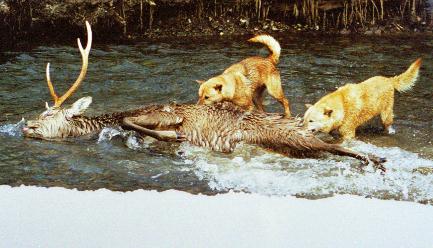 By Nobuyuki Abe |
| HOW
TO KEEP (1) Nutrition The Hokkaido-Inu usually follows a plain diet. The puppy is given a total of 200-400 grams of dry-dog-food per day, divided into 2-4 feedings a day. Then we give the dog some fish meat, too. The adult dog has one meal of 200-300 grams dry-dog-food every day. Since this dog breed drinks water quite often, set a bucket of fresh one. (2) In your back yard The Hokkaido-Inu dislikes having something on its body. He will remove it. Since the dog needs hard exercise, let the dog run loose in your back yard with high fence. Don't keep on tying the dog to a stake. Use a soft and strong collar, if you want to use a collar in the back yard. We usually don't use a collar there. Both indoors and outdoors, you can use a soft, strong and simple collar. Don't hang a name tag on the collar, because the dog will try to bite it off. (3) Outdoors It is best to leave the Hokkaido-Inu in your car, if you want to have it waiting. Keep on a strong chain, if you want to tie the dog to a tree for a while. If the leash is not strong, the dog tears it to run after you. Because he is bold and active and has a tendency to cross a way unconcernedly, look out for traffic and put down his behavior. (4) Indoors
It's all right to keep him indoors for
a short time or to let him sleep indoors at night, but not
all day long.
Since he is bold but depends on the goodwill of its
owner, sometimes you would rather keep him indoors than
outdoors.
If your puppy urinates on the floor, tell him off hard with his muzzle placing in the pee. If you drop a scrap of paper on the floor on purpose before your puppy, he jumps at the paper at once. At that moment, tell him off hard, and he will become a good dog. Naturally, tell the puppy off hard then and there, when he damages something in the room. (5) Health Provide good shade during the summer, as he originated in a cold district, Hokkaido. If he has a poor appetite because of the heat in the daytime, let him go into the room that the air conditioner is working. In warm weather, don't make him jog in the glaring sunlight but instead have light exercise at night or early morning. Take the medicine for protection against filariasis, if he lives in a warm area. (6) Care Brush his hair, when he is losing a lot of hair or when his body is covered with mud. (7) Dog show If you train for a dog show, have your dog run by bicycle or motorcycle, and also have him walk and jog on a short leash. (8) Training If you can't tell off the Hokkaido-Inu bravely, don't keep it. The dog is wild dog!!! It has been bred like a wolf for hunting. On the other hand, it has always hoped to be with humans. The native Japanese breeds differ from the European and American breeds that have been improved to be easy to handle. Only a few Japanese people can keep those breeds well, but the Shiba is easy to handle. Even if you send your bad adult dog to training school, the dog would return home without becoming good like the other native Japanese breeds. |
|
PRESERVATION SOCIETY In Japan, we have three major preservation societies of the Hokkaido-Inu. Our web site inquired about each of the names in the English language. All of the societies are located in Hokkaido. 1. Nippon Kennel Club (Hokkaido-Ken Natural Association)
phone : 059-256-3594
http://nipponkennelclub.com/blog-category-1.html 2. The Corporate Society for the Conservation of the Hokkaido Dog, Natural Monument 3. Hokkaido-Inu Association |
|
BREEDER Even at Japanese pet shops, you can't find the Hokkaido-Inu. The members of the preservation societies have the dogs, because they maintain the best characteristic for the breed. Only Juro Maki (living in Sapporo, Hokkaido) is a full-time breeder, who also deals in the other breeds. As a matter of fact, the other breeders such as Toshio Kudo (living in Sapporo, Hokkaido) and Masao Takekata (living in Wakkanai, Hokkaido) have a regular job and they are the dog fanciers and excellent handlers. They are the officers of the societies. I'm sorry to say, but both these breeders and the preservation societies don't deal in the dog for overseas export. If you have a wish to get the dog no matter what, please contact our web site. We can export it as business. |


